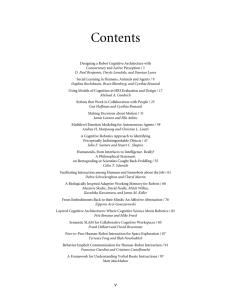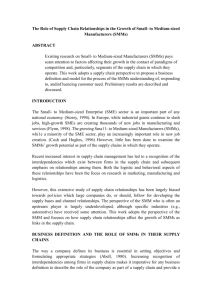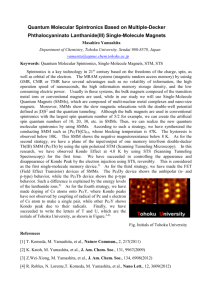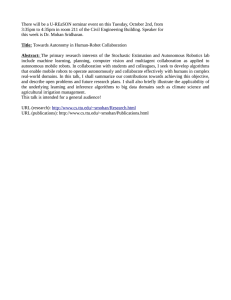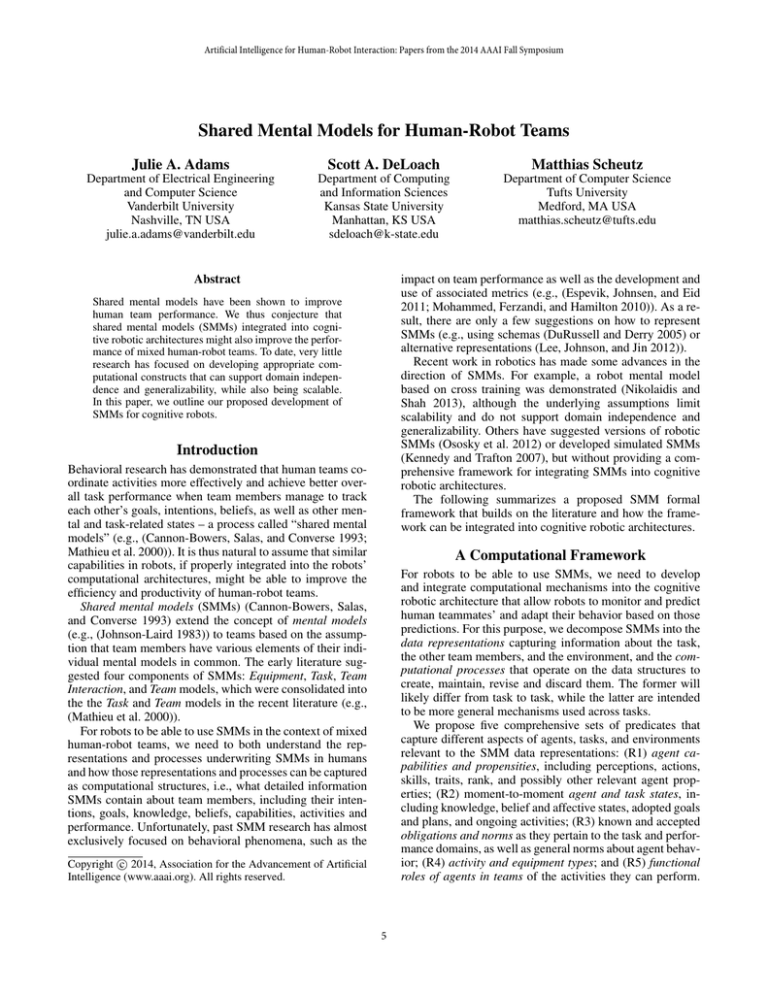
Artificial Intelligence for Human-Robot Interaction: Papers from the 2014 AAAI Fall Symposium
Shared Mental Models for Human-Robot Teams
Julie A. Adams
Scott A. DeLoach
Matthias Scheutz
Department of Electrical Engineering
and Computer Science
Vanderbilt University
Nashville, TN USA
julie.a.adams@vanderbilt.edu
Department of Computing
and Information Sciences
Kansas State University
Manhattan, KS USA
sdeloach@k-state.edu
Department of Computer Science
Tufts University
Medford, MA USA
matthias.scheutz@tufts.edu
Abstract
impact on team performance as well as the development and
use of associated metrics (e.g., (Espevik, Johnsen, and Eid
2011; Mohammed, Ferzandi, and Hamilton 2010)). As a result, there are only a few suggestions on how to represent
SMMs (e.g., using schemas (DuRussell and Derry 2005) or
alternative representations (Lee, Johnson, and Jin 2012)).
Recent work in robotics has made some advances in the
direction of SMMs. For example, a robot mental model
based on cross training was demonstrated (Nikolaidis and
Shah 2013), although the underlying assumptions limit
scalability and do not support domain independence and
generalizability. Others have suggested versions of robotic
SMMs (Ososky et al. 2012) or developed simulated SMMs
(Kennedy and Trafton 2007), but without providing a comprehensive framework for integrating SMMs into cognitive
robotic architectures.
The following summarizes a proposed SMM formal
framework that builds on the literature and how the framework can be integrated into cognitive robotic architectures.
Shared mental models have been shown to improve
human team performance. We thus conjecture that
shared mental models (SMMs) integrated into cognitive robotic architectures might also improve the performance of mixed human-robot teams. To date, very little
research has focused on developing appropriate computational constructs that can support domain independence and generalizability, while also being scalable.
In this paper, we outline our proposed development of
SMMs for cognitive robots.
Introduction
Behavioral research has demonstrated that human teams coordinate activities more effectively and achieve better overall task performance when team members manage to track
each other’s goals, intentions, beliefs, as well as other mental and task-related states – a process called “shared mental
models” (e.g., (Cannon-Bowers, Salas, and Converse 1993;
Mathieu et al. 2000)). It is thus natural to assume that similar
capabilities in robots, if properly integrated into the robots’
computational architectures, might be able to improve the
efficiency and productivity of human-robot teams.
Shared mental models (SMMs) (Cannon-Bowers, Salas,
and Converse 1993) extend the concept of mental models
(e.g., (Johnson-Laird 1983)) to teams based on the assumption that team members have various elements of their individual mental models in common. The early literature suggested four components of SMMs: Equipment, Task, Team
Interaction, and Team models, which were consolidated into
the the Task and Team models in the recent literature (e.g.,
(Mathieu et al. 2000)).
For robots to be able to use SMMs in the context of mixed
human-robot teams, we need to both understand the representations and processes underwriting SMMs in humans
and how those representations and processes can be captured
as computational structures, i.e., what detailed information
SMMs contain about team members, including their intentions, goals, knowledge, beliefs, capabilities, activities and
performance. Unfortunately, past SMM research has almost
exclusively focused on behavioral phenomena, such as the
A Computational Framework
For robots to be able to use SMMs, we need to develop
and integrate computational mechanisms into the cognitive
robotic architecture that allow robots to monitor and predict
human teammates’ and adapt their behavior based on those
predictions. For this purpose, we decompose SMMs into the
data representations capturing information about the task,
the other team members, and the environment, and the computational processes that operate on the data structures to
create, maintain, revise and discard them. The former will
likely differ from task to task, while the latter are intended
to be more general mechanisms used across tasks.
We propose five comprehensive sets of predicates that
capture different aspects of agents, tasks, and environments
relevant to the SMM data representations: (R1) agent capabilities and propensities, including perceptions, actions,
skills, traits, rank, and possibly other relevant agent properties; (R2) moment-to-moment agent and task states, including knowledge, belief and affective states, adopted goals
and plans, and ongoing activities; (R3) known and accepted
obligations and norms as they pertain to the task and performance domains, as well as general norms about agent behavior; (R4) activity and equipment types; and (R5) functional
roles of agents in teams of the activities they can perform.
c 2014, Association for the Advancement of Artificial
Copyright Intelligence (www.aaai.org). All rights reserved.
5
alter its individual behavior to adjust for human performance
degradations or to augment a human during task executions.
Robots can also use SMM state information to suggest task
reassignments that support more effective team operations.
We have started integrating some of the above mechanisms into the DIARC architecture (Briggs and Scheutz
2012) and are developing a more sophisticated distributed
version of SMMs to support asynchronous updates and distributed synchronization among multiple robots.
Many of the predicates have clear mappings to the SMM
components. For example, the predicate Achieve(π, φ, σ)
represents the achievement of a goal state φ via a plan π
in situation σ maps directly to the SMM Task model, while
the predicate Perceivable(α, X) (meaning that agent α can
perceive X, where X can be a type of agent, object, event,
or activity) maps directly to the Team model.
We propose five corresponding sets of rules to update the
data structures, while addressing how different predicates
are related and how they can be used in the context of teams.
For example, rules for negotiating goals and assignments
with other team members are necessary, because goals can
change or different goal assignments may become necessary
during task execution due to unexpected events or the loss
of capabilities by team members. This allows the formulation of various general principles for proposing plans, for
example, that proposed plans to achieve common goals are
adopted if no previous plans are in place. It is also necessary to be able to specify general principles of what is obligatory, what is permitted, and what is not permitted in the
context of the team, task, and task environment. Overall, updates to a robot’s SMM will be triggered by various events,
mediated through the agent’s perceptual system, and internal state changes. For example, robotA may perceive a new
task-relevant object, which can trigger the instantiation of a
new goal. RobotB observing robotA will also need to update
its model to accommodate robotA ’s new goal.
References
Briggs, G., and Scheutz, M. 2012. Multi-modal belief updates in multi-robot human-robot dialogue interactions. In
Proceedings of AISB 2012.
Cannon-Bowers, J. A.; Salas, E.; and Converse, S. 1993.
Shared mental models in expert team decision making. In
Castellan, N. J., ed., Current issues in individual and team
decision making. Psychology Press. 221–246.
DuRussell, L. A., and Derry, S. J. 2005. Schema
(mis)alignment in interdisciplenary teamwork. In Derry,
S. J.; Schunn, C. D.; and Gernsbacher, M. A., eds., Interdisciplinary Collaboration: An Emerging Cognitive Science.
Lawrence Earlbaum Associates, Publishers.
Espevik, R.; Johnsen, B. H.; and Eid, J. 2011. Outcomes
of shared mental models of team members in cross training
and high-intensity simulations. Journal of Cognitive Engineering and Decision Making 5(4):352–377.
Johnson-Laird, P. N. 1983. Mental Models: Towards a Cognitive Science of Language, Inference, and Consiciousness.
Cambridge: Cambridge University Press.
Kennedy, W. G., and Trafton, J. G. 2007. Using simulations to model shared mental models. In Proceedings of
the Eighth International Conference on Cognitive Modeling,
253–254.
Lee, M.; Johnson, T.; and Jin, M. H. 2012. Toward understanding the dynamic relationship between team and task
shared mental models as determinants of team and individual performances. International Journal of Information
Technology and Business Management 8(1).
Mathieu, J. E.; Goodwin, G. F.; Heffner, T. S.; Salas, E.;
and Cannon-Bowers, J. A. 2000. The influence of shared
mental models on team process and performance. Journal
of Applied Psychology 85(2):273–283.
Mohammed, S.; Ferzandi, L.; and Hamilton, K. 2010.
Metaphor no more: A 15-year review of the team mental
model construct. Journal of Management 36(4):876–910.
Nikolaidis, S., and Shah, J. A. 2013. Human-robot crosstraining: Computational formulation, modeling and evaluation of a human team training strategy. In Proceedings of
the ACM/IEEE International Conference on Human-Robot
Interaction, 33–40.
Ososky, S.; Schuster, D.; Jentsch, F.; Fiore, S.; Shumaker,
R.; Lebiere, C.; Kurup, U.; Oh, J.; and Stentz, A. 2012.
The importance of shared mental models and shared situation awareness for transforming robots form tools to teammates. In Proceedings of SPIE 8387, Unmanned Systems
Technology XIV, 838710–1.
Integration Requirements
The integration of SMMs into cognitive robotic architectures
must allow for efficient and consistent ways to capture, update and synchronize SMM state information, while using
that information to drive robot behavior adaptation. Specifically, the integration needs to allow the robot to (1) directly
observe humans to estimate their current performance fluctuations, (2) track human’s progress toward their assigned
goals, (3) determine the human’s current task focus using
performance estimates, goal assignments and progress, (4)
estimate the human’s cognitive workload based on task focus, (5) predict the implications of new/modified task assignments on the human using performance estimates and
current task focus, and (6) adapt its behavior based on the
measurements and predictions. Steps 1-4 represent update
processes, while steps 5-6 represent control processes.
Update processes observe the environment and other
teammates and use these observations to keep the SMM
Team and Task state current. Such processes include those to
update the equipment status, team and individual human task
status, monitoring for new tasks and assignments, and updating environmental observations, such as noise, temperature,
humidity, etc. Additionally, update tasks can be used to monitor human performance factors that can help predict human
performance of assigned tasks. These update processes can
be quite complex and make use of real-time observations as
well as current performance estimates stored in the SMM.
Control processes use the SMM state information to control and adapt a robot’s behavior and modify the team’s organization. Using the current team and task state information,
along with predictions of human performance, the robot can
6

